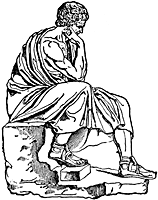 A Dynamic Point of View on Psychology and Values
A Dynamic Point of View on Psychology and Values, in Arabic, ISBN 977-205-024-2, Cairo, Egypt 1988.
I was armed with the analysis tools of nonlinear dynamic systems and wanted to apply the math to model human behavior. My main question was: How should behavior be classified in order to apply nonlinear control systems theory? This book shows the direction which oriented me for the next 20 years.
Boolean Psychology
George Boole is a 19th century Irish mathematician; he was the father of Boolean algebra, the foundation of modern computer science. Boolean logic is the justification of his algebra according to which a logical yes-or-no question has four answers: 1-Yes, 2-No, 3- Combined Yes
and No or
relevant but
don't know, and 4- Neither Yes nor No or irrelevant and don't care. Since Boole determined that there cannot be any logical possibility of an answer outside these four, he suggested that human behavior and the organization of the brain is divided into four categories or interacting networks corresponding to the logical answers. Reflecting on these answers, I suggested that there should be at least four major categories of drives or motivations in humans, and I suggested definitions based on types of animal aggression as immediate self-preservation or emotions, feeding, sociosexual and parenting motivations. All emotions are motivations but not all motivations are emotions.
Man as a Multimeter
I was heavily involved in electrical measurements at the time of writing this book, which influenced my approach to studying human and animal behavior. I observed the weakest link in the practice of human sciences from a concrete scientific view was the interpretation of behavior, I suggested that interpretation is a process of measurement analogous to the measurement of voltage or electrical current, therefore we need to define and separate the aspects of validity and reliability in order to place human sciences on a firm scientific ground. After searching and pondering the aspects of interpretations most similar to accuracy and resolution in measurement, which correspond to validity and reliability in human sciences, I settled on the definitions of motivation and cognition respectively as coming closest. I observed that cognition refers to largely objective distinctions that can be carried out to a very fine degree, similar to resolution and reliability. And that motivation must refer to a subjective state with known time constancy or dependency, similar to accuracy and traceability in measurement and validity where the existence of a true outside reference must be assumed for calibration. I argued that the parallel goes all the way to ancient Greek philosophy: Motivation and validity are similar to Plato's world of ideals or synthesis while cognition and reliability are to Aristotelian analysis.
All scientific measurements reference the observer..To an extent
Some people may assume that science is completely neutral and detached from the observer, I know I did, but it came as a surprise when I found out that even the definition of the volt is subject to international disagreement; there are different national measures of the volt where the difference between the highest and lowest can be up to 9 parts per million. The amount may not be significant in practice but the principle is unmistakable: The observer decides which volt to use, and you cannot separate subjectivity from objectivity anymore than separating motivation from cognition. I found out only recently that this idea is in line with second order cybernetics.
Measuring good and evil
I am not sure if the discourse on good and evil is relevant to artificial psychology so I will make it brief. I argued that good could be referenced (with limitations) to the value of money or gold the way scientific measures reference time. I observed that money or gold are less stable than money or gold and concluded that in the end, money and gold should be measured against time and these were the concluding remarks of the book. As an unpublished corollary, I compared good and evil and found that they belong to different classes, to my mind they were not opposite. Good has a time dimension like motivation while evil is the result of misplaced identification of an aggressor, like a cognitive error with no time dimension. I speculate that good and evil are, in a sense, complimentary rather than opposite.




